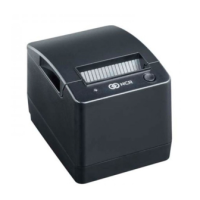7197 Series II Owner’s Guide Chapter 6: Commands
August 2011
145
7 Off 00 0 Not used. Fixed to off.
Real Time Request to Printer
GS Sequence
Standard/Ethernet
DLE Sequence
Standard/Ethernet
Non ION USB
ASCII: GS ETX n DLE ENQ n NAK STX n (bRequest = NAK,
wValue = STX n)
Hexadecimal: 1D 03 n 10 05 n 15 02 n (bRequest = 0x15,
wValue = 0x02 n)
Decimal:
29 3 n 16 5 n 21 2 n (bRequest = 21, wValue
= 2 n)
Value of n:
1 = Recover and restart
2 = Recover and clear buffers
According to “Ethernet RTC Protocol” setting ( 1F 11 ) , the using protocol and port
number are different. When “Ethernet RTC Protocol” setting is TCP, this command ( n = 1
to 3 ) effective in TCP 9100 port. “Ethernet RTC Protocol” setting is UDP, this command
effective in UDP 3000 port.
When send above command to the printer by Ethernet (UDP 3000 port), need to add
Sequence Number of 4 bytes before command.
In case of Recover and restart command, send xxh xxh xxh xxh 1Dh 03h 01h.
“xxh xxh xxh xxh“ is Sequence Number.
The printer responds to a request from the host specified by n. This command includes
two sequences: GS and DLE. The operations performed depend on the value of n,
according to the following parameters.
n = 1:
Restarts printing from the beginning of the line where an error occurred, after recovering
from the error. Print settings that are normally preserved from line to line, such as
character height and width, are still preserved with this command. This sequence is
ignored except when the printer is busy due to an error condition.
If the receipt is selected, this command will attempt recovery from a knife error. Other
errors associated with the receipt, such as paper out or print head overheating, can be
recovered from only by clearing the specific condition, such as loading paper or letting the
print head cool down.
n = 2:
Recovers from an error after clearing the receive and print buffers. Print settings that are
normally preserved from line to line, such as character height and width, are still

